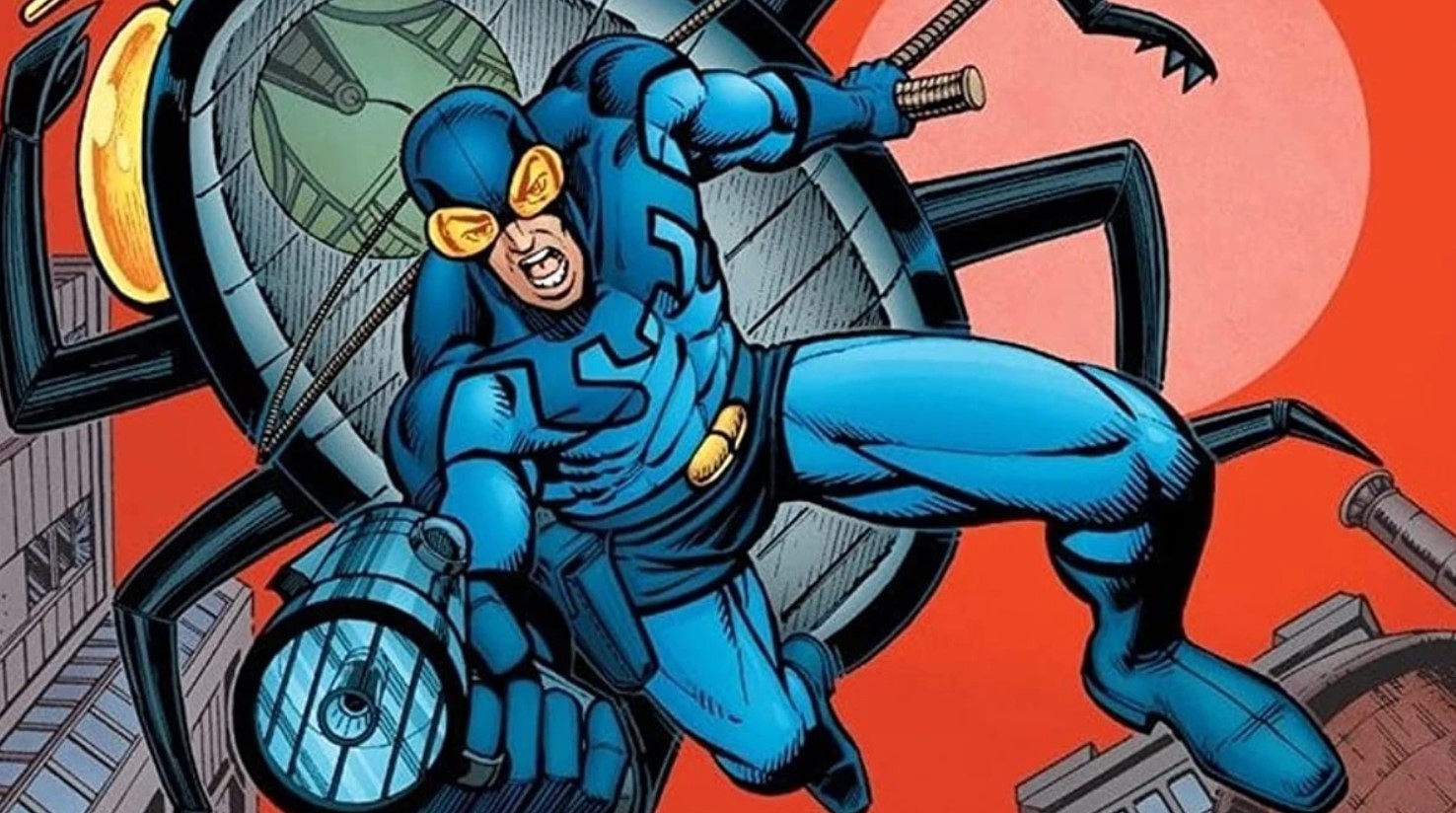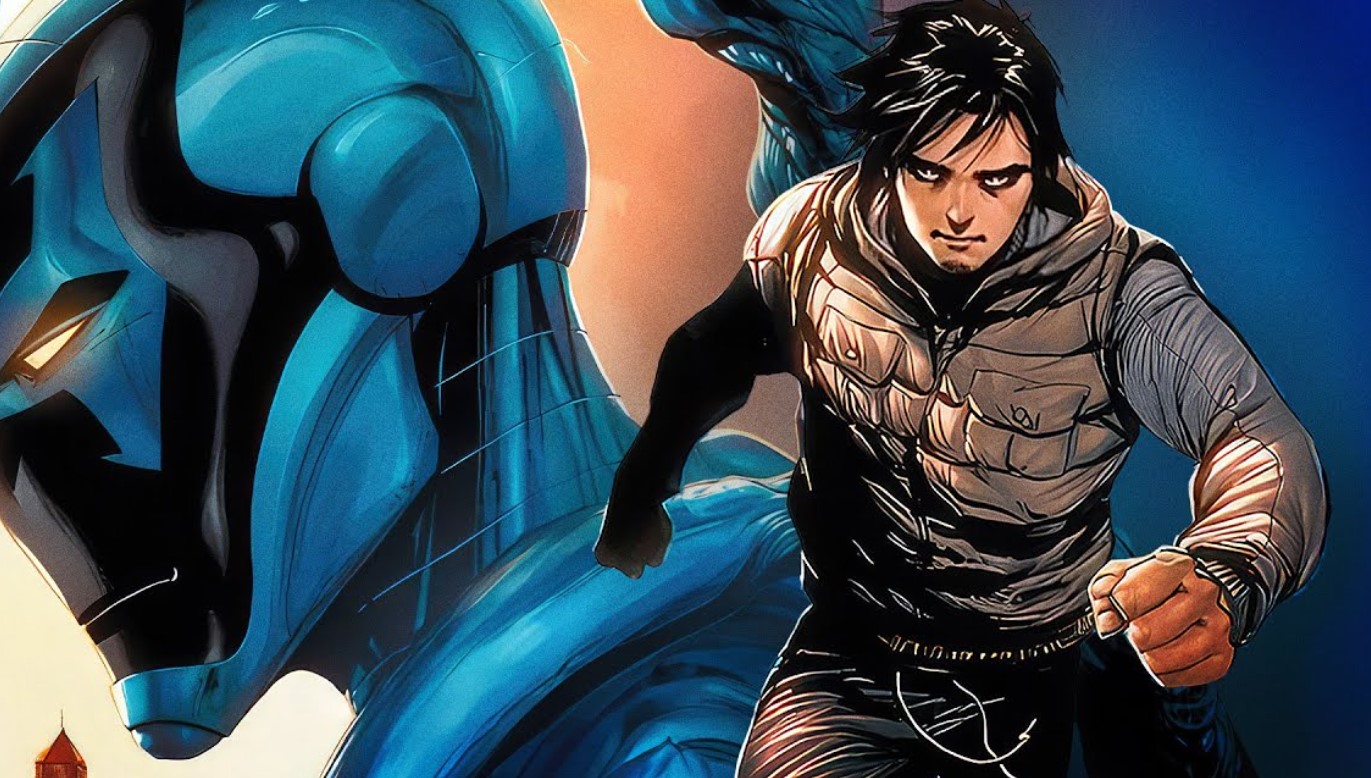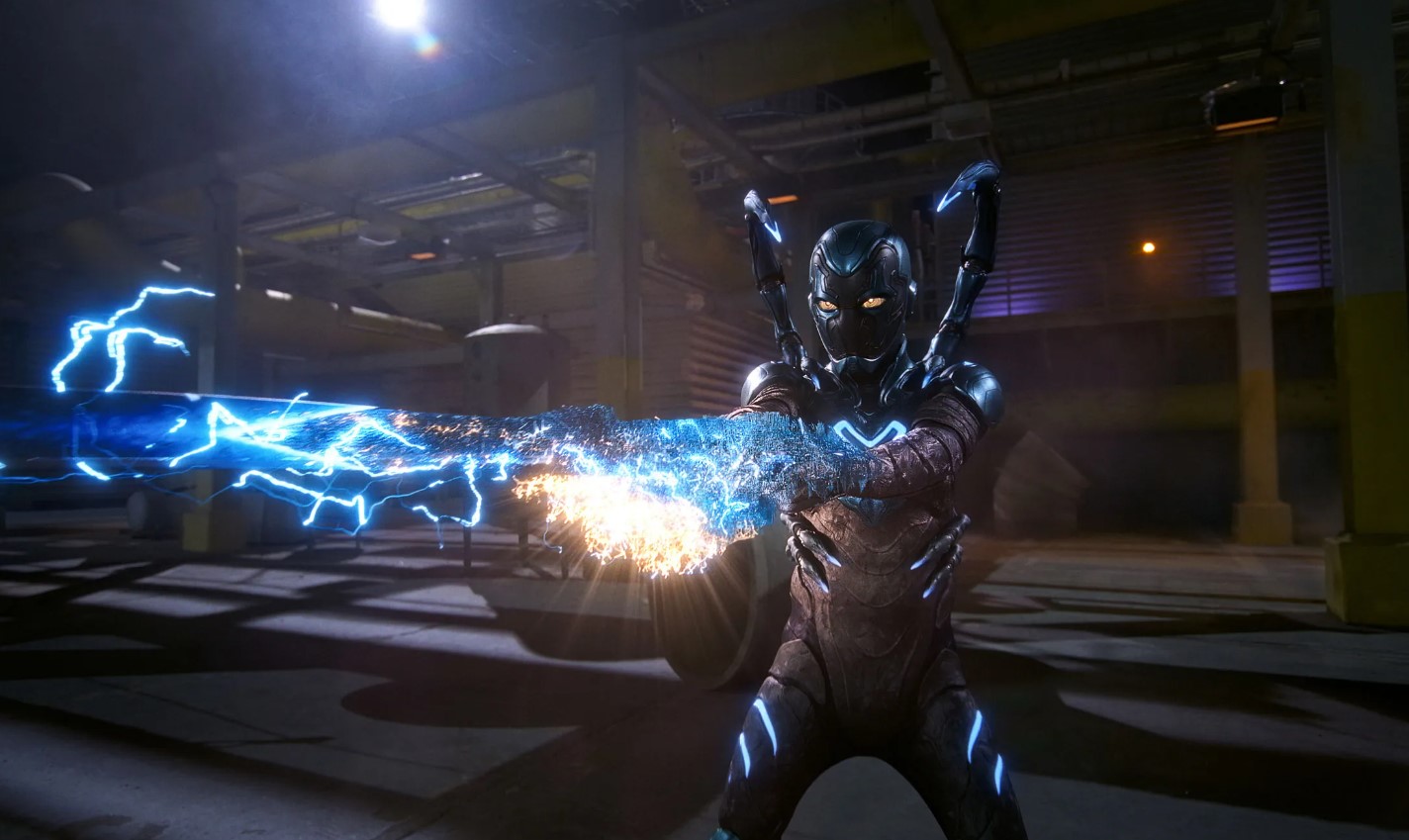Blue Beetle’s origins trace back to the golden age of comics, with the character making his first appearance in 1939, under the Fox Comics banner. The original Blue Beetle was Dan Garrett, an archaeologist who obtained superhuman abilities from a mystical scarab he found during an expedition. Garrett took on the title of Blue Beetle to combat nefarious activities, drawing on his newfound abilities to transform into a superhuman form, possessing Herculean strength, invulnerability, and the power to fly. Despite Garrett’s death, his legacy as the Blue Beetle lived on through his successors.
The second Blue Beetle, Ted Kord, was introduced by Charlton Comics in the 1960s. Instead of mystical powers, Kord was a genius-level inventor who relied on his combat skills and high-tech equipment. In 1986, DC Comics acquired the rights to Blue Beetle, incorporating the character into their universe. The third and current Blue Beetle is Jaime Reyes, a teenage Latino introduced in 2006. Unlike his predecessors, Reyes fused with the scarab, which now provides him with an alien suit of armor. Blue Beetle’s beginnings underline the character’s evolution, adapting to different eras while maintaining the core concept of an ordinary individual granted extraordinary abilities to protect the innocent.

Rise of the Pulp Heroes
Pulp fiction, a genre characterized by its cheap paper and sensationalist narratives, experienced a significant surge in popularity during the early 20th century, specifically the 1930s and 40s. This period marked the rise of the Pulp Heroes – a collection of larger-than-life characters who emerged from the pages of these inexpensive novels and magazines to become cultural icons. These characters, from the Shadow to Doc Savage, and from the Phantom to the Spider, embodied justice, courage, and resourcefulness. They were revered by their readers for their ability to confront adversity head-on, usually in the form of villainous adversaries, and come out victorious.
These heroes were not just figures of physical strength, they were also sharp-witted, possessing a keen intellect that they used to outsmart their opponents. As these characters grew in popularity, they began to influence other forms of media, such as radio, cinema, and later television, shaping the archetype of the superhero that we know today. Despite the often gritty and violent nature of their stories, these Pulp Heroes were seen as beacons of hope during a period of global economic crisis and political unrest. They offered an escape for their readers, presenting them with a world where justice could always be achieved, regardless of the odds. And while the pulp magazines themselves have largely faded into obscurity, the impact of the Pulp Heroes on popular culture remains profound and enduring.
The Blue Beetle Legacy
The Blue Beetle Legacy is an iconic aspect of comic book history that has transcended several generations. Originating in the 1930s, this superhero mantle has been carried by three different characters, each with their own unique contributions to the iconic image. The initial bearer was Dan Garrett, an archaeologist who discovered a mystical scarab that gave him superhuman abilities. Later, the mantle was passed onto Ted Kord, a student of Garrett, who, despite not having superpowers, used his intellect and scientific prowess to uphold the legacy. Lastly, the scarab found its way to Jaime Reyes, a teenager who provided a fresh, youthful perspective to the role.
Each of these iterations of the Blue Beetle brought a new dimension to the character, evolving and adapting him to the changing times. The narrative of the Blue Beetle has been constantly reinvented while maintaining its core essence, thus ensuring its relevance in the modern era. As part of the DC Universe, the Blue Beetle’s narrative has been intertwined with those of other legendary superheroes and has played a significant role in some of the most prominent storylines. The Blue Beetle Legacy is a testament to the enduring appeal of superhero narratives and their ability to constantly adapt and evolve to remain relevant. It is a symbol of heroism, courage, and resilience that continues to inspire comic book enthusiasts across the globe.
Interdimensional Adventures
Interdimensional adventures open up an exhilarating world of unexplored possibilities, where the boundaries of our understanding are constantly pushed to the brink. It is a concept deeply rooted in the realm of science fiction, often featured in books, movies, and video games. The idea revolves around the existence of multiple dimensions or universes, each with their own unique realities, beyond the three spatial and one temporal dimensions that we are familiar with. Traveling across these dimensions or ‘interdimensional travel’ is a tantalizing prospect, allowing adventurers to experience worlds vastly different from ours.
These adventures often involve unexpected twists, as the rules of physics and reality may differ significantly from one dimension to another. For instance, a parallel universe could potentially have a different gravitational pull, a unique set of species, or even an alternate history. This makes interdimensional adventures a thrilling journey of discovery, where each new dimension offers a fresh perspective and unforeseen challenges.
For the adventurers, it’s not merely a physical journey, but also a mental and emotional one. The ability to adapt to new environments, understand diverse cultures, and make critical decisions in high-stakes situations is essential. While the concept of interdimensional travel is currently beyond our technological capabilities, it continues to captivate our imaginations.
Moreover, interdimensional adventures often underline the importance of unity and tolerance. As travelers encounter beings from different dimensions, they are reminded of the vast diversity in the multiverse and the significance of coexistence despite differences. These adventures serve as a metaphorical exploration of our own world’s cultural, social, and biological diversity.
In conclusion, interdimensional adventures are a fascinating blend of scientific speculation and imaginative storytelling. They provide a captivating narrative that challenges our perception of reality and encourages us to think beyond the confines of our own universe. While we may not be ready to embark on such a journey in reality, they continue to serve as an enduring source of inspiration and exploration in the realm of fiction.
Dual Blue Beetle Identities
The Blue Beetle is a comic book superhero that has been reimagined several times since its inception in 1939. Two of the most notable identities of the Blue Beetle are those of Ted Kord and Jaime Reyes. Ted Kord, the second Blue Beetle, was a gifted inventor and athlete, who, despite lacking the mystical abilities of his predecessor, relied on his intellect and physical prowess to combat crime. He was known for his light-hearted and humorous approach to his superhero persona. Kord’s Blue Beetle was a reflection of the Silver Age of comic books, characterized by optimism, wit, and a sense of fun.
On the other hand, Jaime Reyes, the third and current Blue Beetle, is a teenager who stumbled upon the Blue Beetle scarab, which fused with his spine and granted him extraordinary powers. Unlike Kord, Reyes deals with darker themes and struggles, including the constant battle for control with the scarab, which has a violent and aggressive mind of its own. This version of the Blue Beetle is reflective of modern comics, where narratives often explore complex themes and moral ambiguity.
Despite their differences, both Kords and Reyes’ versions of the Blue Beetle share a commitment to justice and a sense of responsibility towards their community. They both juggle their superhero duties with their personal lives, illustrating the human behind the superhero mask. Furthermore, they represent the evolution of the Blue Beetle character, demonstrating how it has adapted and changed to reflect the tastes and attitudes of different generations. The dual identities of the Blue Beetle, therefore, not only provide diversity in storytelling but also offer a unique insight into the evolution of comic book superheroes. The constant reinvention of the Blue Beetle identity ensures that it remains relevant and relatable to its readers, regardless of the era.

Vigilance Over Nite Owl
The topic of vigilance over Nite Owl is an intriguing one. Nite Owl, a popular establishment that operates during the late hours, has been the subject of scrutiny and oversight for a variety of reasons. This round-the-clock establishment, which serves as a haven for nocturnal patrons, has been under surveillance by concerned entities due to the issues and incidents related to its operating hours. The attention given to Nite Owl stems from the inherent risks and problems that can arise during these late hours. With this in mind, vigilance over Nite Owl becomes a necessary measure to ensure the safety and wellbeing of its patrons and the surrounding community.
This vigilance can come in the form of increased security personnel, stringent checks at the entry points, and more thorough oversight of the activities within the premises. The goal is not to hinder its operation but to maintain a peaceful and safe environment. The supervision over Nite Owl is a testament to the broader societal commitment towards maintaining order and safety even during the unconventional hours. It highlights the need to adapt conventional oversight mechanisms to suit the changing lifestyles and habits of people. Vigilance over Nite Owl, therefore, stands as a symbol of a society’s commitment to protect its citizens at all times.
Era of Lightheartedness
The Era of Lightheartedness represents a period characterized by joy, mirth, and an overall sense of buoyancy. It was a time when the world seemed to be in a perpetual state of celebration, where merriment was the order of the day, and worry or stress were mere afterthoughts. Individuals reveled in the pleasure of simple things, finding happiness in the tranquil beauty of a blooming flower, the soothing melody of a bird’s song, or the infectious laughter of a friend. The atmosphere was infectious, spreading from person to person like a sweet contagion of positivity.
People were genuinely content, embracing life with a kind of optimistic fervor that was as refreshing as it was invigorating. There was a vibrant energy that filled the air, a palpable sense of euphoria that was impossible to ignore. This was a period of blissful innocence, where the world was viewed through rose-colored glasses, and every day was a new opportunity to experience the simple joys of life.
The Era of Lightheartedness was a time when life was savored, when every moment was cherished and appreciated. It was a time when people weren’t weighed down by the burdens of life but instead floated on the wings of delight and ecstasy. This era also fostered a strong sense of community, where people were more connected and supportive of each other. The collective mood was one of unity and camaraderie, as individuals celebrated not just their own happiness, but the happiness of those around them.
In this era, the spirit of playfulness and fun reigned supreme. There was an air of spontaneity and a lack of inhibition that allowed people to fully express themselves, to be uninhibited and free. This was an era where the joy of living was celebrated, where laughter was the universal language and happiness, the ultimate currency. It was truly an era that epitomized the phrase ‘joie de vivre.’
Emergence of a New Hero
In a world where chaos and uncertainty often abound, the emergence of a new hero can spark hope in the hearts of many. This individual does not don a cape nor possess superhuman powers but his strength lies in his resilience, fortitude, and the implicit belief in the potential for positive change. His presence illuminates the darkest corners, casting away shadows of fear and despair. The birth of this hero is not marked by grandeur, rather it is a subtle transformation that begins within. It is a stirring, a shift in perspective that enables him to see beyond the tangible and envision a world that thrives in unity, compassion, and fairness.
He is not a conventional warrior wielding a sword, but one who employs wisdom, empathy, and courage as his weapons. His battles are not against external foes but against the internal demons of apathy, prejudice, and divisiveness that plague society. He is an advocate for peace, a beacon of hope, and a champion of the virtues that elevate humanity above its flaws. This hero is not defined by his victories but by his struggles, for it is in the crucible of adversity that his true character is revealed.
The emergence of such a hero is a powerful testament to the indomitable spirit of mankind. He is a reminder that every individual possesses the capacity for greatness, the potential to effect meaningful change, and the ability to inspire others. This hero is not an anomaly, he is a mirror reflecting the best version of ourselves. His story is not one of sudden metamorphosis, but a testament to the power of perseverance, compassion, and unshakable conviction. He rises, not because he is invincible, but because he dares to stand up every time he falls. His emergence is not an end, but a beginning – a call to action for every individual to rise above their limitations and strive for a better world.
Tinseltown’s Beetle Buzz
Tinseltown’s Beetle Buzz is an intriguing phenomenon that’s been causing a stir in Hollywood. This isn’t your ordinary bug infestation; rather, it’s a rising fascination with the world of beetles. An increasing number of celebrities are taking interest in these insects, leading to a surge of beetle-themed jewelry, home decor, and even film and TV projects. The trend, initially sparked by a few high-profile names, has now ignited a wildfire of beetle admiration across the entertainment industry.
Beetles, specifically, have captured the attention and imagination of Hollywood’s elite due to their striking diversity and fascinating symbolism. With over 400,000 known species, each exhibiting unique characteristics and behaviors, beetles represent a vast and unexplored world of inspiration for the creative minds in Hollywood. Their symbolism, representing transformation and rebirth, resonates strongly with many individuals who have experienced their own personal transformations in the spotlight.
For example, movie stars have been spotted wearing beetle brooches at red carpet events, while interior design magazines reveal beetle motifs in the homes of A-listers. Even the film industry is getting in on the action, with several upcoming releases featuring storylines centered around these captivating creatures.
The Beetle Buzz has also influenced fashion designers to incorporate beetle imagery into their collections, resulting in stunning, one-of-a-kind pieces. From shimmering scarab pendants to intricate beetle-patterned textiles, these designs are quickly becoming must-have items in celebrity wardrobes.
It appears that Tinseltown’s Beetle Buzz is more than just a passing fad. The beetle, with its vibrant colors, intricate patterns, and symbolic significance, has proven to be a powerful muse for Hollywood’s creative community. As the trend continues to spread, it’s clear that the humble beetle has found a place in the glitz and glamour of Tinseltown.

Blue Beetle Hits the Silver Screen
DC Comics character, the Blue Beetle, has finally made his grand debut on the silver screen, much to the delight of his legion of fans worldwide. The movie, which is a visual spectacle, explores the life and adventures of Ted Kord, a genius inventor who assumes the mantle of the Blue Beetle after his mentor’s demise. The narrative not only captures the thrilling exploits of the Blue Beetle as he battles against a plethora of adversaries but also delves into the complex dynamics of his personal life. This comic-based film artfully blends elements of action, drama, and humor, resulting in a cinematic experience that is as engaging as it is entertaining.
The portrayal of the Blue Beetle by the lead actor is commendable, with the actor perfectly embodying the charm, wit, and courage of the iconic superhero. The film’s special effects are top-notch, enhancing the larger-than-life battles between the Blue Beetle and his foes. The supporting cast also delivers stellar performances, adding depth to the narrative and complementing the protagonist’s journey.
The movie stands out not just for its gripping storytelling and impressive visuals, but also for its exploration of themes such as friendship, sacrifice, and resilience, making it a deep and meaningful viewing experience. The screenplay is well-crafted, with the dialogues reflecting the comic’s authentic tone. The film’s music score perfectly complements the plot, heightening the suspense and drama during the action sequences.
In conclusion, the Blue Beetle’s silver screen outing is a triumph, delighting comic fans and winning over new audiences with its engaging narrative, stellar performances, and impressive special effects. It is a testament to the enduring appeal of the Blue Beetle, and a celebration of the superhero’s enduring legacy in the world of comics. The movie is sure to pave the way for more adaptations of beloved comic characters in the future, as audiences continue to be captivated by their thrilling adventures and inspiring stories.
